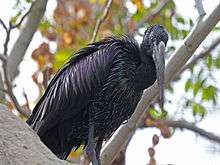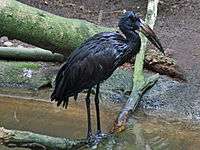African openbill
| African openbill | |
|---|---|
| | |
| Scientific classification | |
| Kingdom: | Animalia |
| Phylum: | Chordata |
| Class: | Aves |
| Order: | Ciconiiformes |
| Family: | Ciconiidae |
| Genus: | Anastomus |
| Species: | A. lamelligerus |
| Binomial name | |
| Anastomus lamelligerus Temminck, 1823 | |

The African openbill (Anastomus lamelligerus) is a species of stork in the Ciconiidae family.
Description
The African openbill is an 80–94 cm long stork with a weight of 1–1.3 kg. Its adult plumage is generally dark overall, with glossy green, brown, and purple on the mantle and breast. The bill is brownish and notably large. The legs are black, and the eye is grey. The juvenile plumage is more dull and brown, with areas of pale feather tips.[2]
Habitat and distribution
The African openbill is found in throughot sub-Saharan Africa from Senegal east to Ethiopia and then south as far as KwaZulu Natal in eastern South Africa.[1][3]
It is a bird of shallow wetlands and can be found wherever its molluscan prey is available including emporarily flooded pans, flood plains, swamps, marshes, ponds, streams, river shallows, dams, rice paddies, lagoons, lake margins and intertidal mud flats.[3]
Behavior
The African openbill feeds almostly exclusively on aquatic snails and freshwater mussels.[3] It will, however, it will also eat terrestrial snail, frogs, crabs, fish, worms, and large insects. It uses its bill to detects its prey, and can use it in such a way that it easily pries open molluscs. It tends to feed singly or in small groups.[2]
The African Openbill breeds during the rainy season, due to the higher availability of snails at that time. During that period, they perform complex displays, often involving bobbing, bill-clattering, and a performance involving rocking back and forth with the head held between the legs. They nest in colonies in trees, which is typical of storks. The nest is made of sticks and reeds, and is roughly 50 cm wide. Storks typically lay 3-4 oval, chalky-white eggs. Eggs are incubated for both sexes for 25–30 days. The chicks and downy and black with a normal sized bill, and they leave the nest 50–55 days later.[2]
The African Openbill is mainly resident and non-migratory, however it may undertake nomadic movements, sometimes flocks move away from arid regions when the dry season begins.[3]
Gallery
References
- 1 2 BirdLife International (2012). "Anastomus lamelligerus". IUCN Red List of Threatened Species. Version 2013.2. International Union for Conservation of Nature. Retrieved 26 November 2013.
- 1 2 3 Bouglouan, Nicole. "African Openbill". oiseaux-birds.com. oiseaux-birds. Retrieved November 1, 2015.
- 1 2 3 4 "Anastomus lamelligerus (African openbill, Openbilled stork)". Biodiversity Explorer. Iziko Museums of South Africa. Retrieved 2016-11-08.
External links
| Wikispecies has information related to: Anastomus lamelligerus |
| Wikimedia Commons has media related to Anastomus lamelligerus. |


